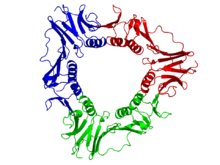DNA clamp

A DNA clamp ( English DNA clamp, sliding clamp ) is a protein structure in some DNA -binding proteins that is used to bind a DNA-modifying enzyme to the DNA during DNA replication . The DNA clamp consists of several proteins with an approximately wedge-shaped structure with protein domains for sequence-independent DNA binding and for multimerization , resulting in the typical ring shape.
As a necessary component of a protein complex with DNA polymerase III , it binds the polymerase to the DNA. The interactions between the polymerase and the DNA clamp and the interactions between the DNA clamp and DNA are stronger than between the polymerase and the DNA.
DNA clips can be genetically attached to thermostable DNA polymerases in the course of protein design . Such fusion proteins have an increased number of synthesized nucleobases in one run (increased processivity ) and an increased synthesis rate and are therefore used for the polymerase chain reaction . The DNA clamp can increase the synthesis rate by a factor of 1000.
literature
- Watson JD, Baker TA, Bell SP, Gann A, Levine M, Losick R: Molecular Biology of the Gene . Pearson / Benjamin Cummings, San Francisco 2004, ISBN 0-8053-4635-X .
Web links
- SCOP DNA clamp fold
- CATH box architecture
- Clamping down on pathogenic bacteria - how to shut down a key DNA polymerase complex. Quips at PDBe
- MeSH DNA clamp
Individual evidence
- ↑ PDB 1W60 ; Kontopidis G, Wu SY, Zheleva DI, Taylor P, McInnes C, Lane DP, Fischer PM, Walkinshaw MD: Structural and biochemical studies of human proliferating cell nuclear antigen complexes provide a rationale for cyclin association and inhibitor design . In: Proc. Natl. Acad. Sci. USA . 102, No. 6, February 2005, pp. 1871-6. doi : 10.1073 / pnas.0406540102 . PMID 15681588 . PMC 548533 (free full text).
- ^ V. Mizrahi, RN Henrie, JF Marlier, KA Johnson, SJ Benkovic: Rate-limiting steps in the DNA polymerase I reaction pathway . In: Biochemistry . 24, No. 15, 1985, pp. 4010-4018. doi : 10.1021 / bi00336a031 .

